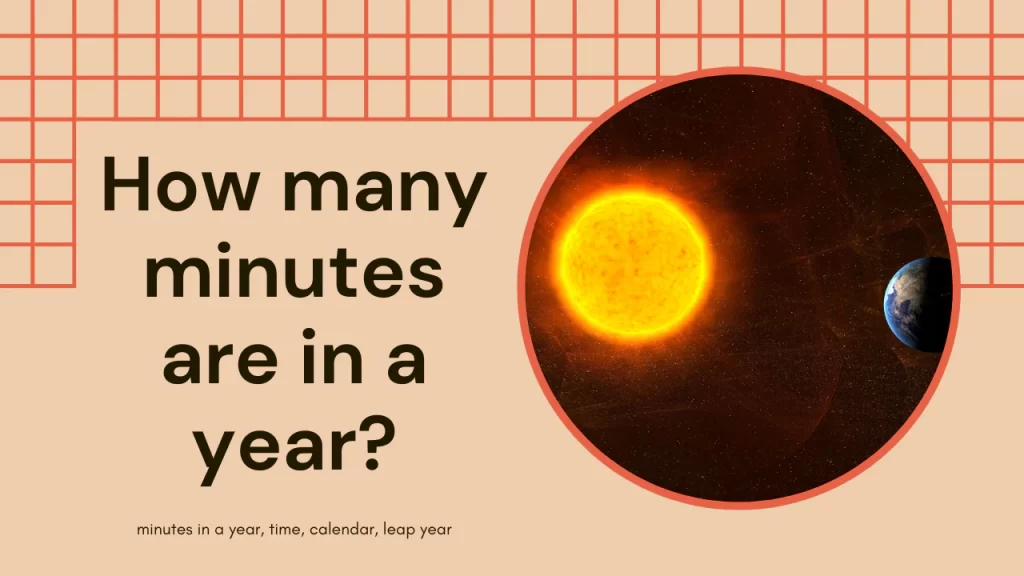How Many Minutes in a Year? A Timekeeper’s Trek Through the Calendar
Have you ever gazed at the clock, mesmerized by the relentless ticking of seconds, and wondered, “Just how many minutes are there in a year?” This seemingly simple question delves into the fascinating world of calendars and timekeeping. Buckle up, because we’re about to embark on a journey to unravel the answer and explore the intricacies of measuring a year in minutes.
Unveiling the Building Blocks: Days and Leap Years
-
The Foundational Day: Our quest begins with the basic unit of timekeeping: the day. We on Earth experience a day due to the planet’s rotation on its axis. One complete rotation takes roughly 24 hours, marking the familiar cycle of day and night.
-
A Year in Days: But how many days are there in a year? Here’s where things get interesting. A year is traditionally defined as the time it takes for Earth to complete one revolution around the sun. This solar cycle, however, isn’t a perfect 365 days. It’s actually slightly longer, clocking in at roughly 365.2422 days.
-
The Leap Year Conundrum: To account for this discrepancy and keep our calendars aligned with the seasons, we introduce the concept of a leap year. A leap year is a year with an extra day added in February, bringing the total number of days to 366. Leap years occur almost every four years, with a few exceptions (we’ll explore those later).
Calculating Minutes: The Leap Year Impact
Now that we understand the building blocks of days and leap years, let’s get down to calculating minutes in a year. Here’s the breakdown:
-
Minutes in a Day: There are 60 minutes in an hour, and 24 hours in a day. So, we have 60 minutes/hour * 24 hours/day = 1440 minutes per day.
-
Regular Year Minutes: If a year has 365 days (not a leap year), the total number of minutes would be: 1440 minutes/day * 365 days/year = 525,600 minutes in a year.
-
Leap Year Minutes: In a leap year with 366 days, the total number of minutes would be: 1440 minutes/day * 366 days/year = 527,040 minutes in a year.
Therefore, depending on whether the year is a leap year (366 days) or a regular year (365 days), there are either 527,040 minutes or 525,600 minutes in a year.
A Peek at Leap Year Logic: Why Not Every Four Years?
While leap years occur almost every four years, a slight adjustment is needed to maintain accuracy in our calendars over long periods. Here’s why:
-
The Decimal Dilemma: Remember, our solar year is roughly 365.2422 days, not a perfect 365 days. Adding a leap year every four years corrects most of the discrepancy, but there’s still a tiny leftover decimal.
-
Century Year Exception: To account for this leftover decimal, we have a special rule for century years (years ending in 00). Not all century years are leap years. Only century years divisible by 400 are considered leap years.
For instance, the year 1900 wasn’t a leap year, but the year 2000 (divisible by 400) was a leap year. This exception ensures our calendars stay synchronized with the solar cycle over centuries.
Beyond Minutes: A Universe of Timekeeping
Our exploration of minutes in a year sheds light on the complexities of timekeeping. But time is a vast concept, measured in various ways:
-
Seconds: We often use seconds for even smaller time measurements, with 60 seconds in a minute.
-
Hours: Minutes can be grouped into hours (60 minutes in an hour), a more common unit for daily activities.
-
Weeks and Months: Our calendars are further divided into weeks (7 days) and months (varying lengths), providing a framework for scheduling and organization.
Frequently Asked Questions about Minutes in a Year
Q: Is there a quick way to estimate how many minutes are in a year without complex calculations?
A: Absolutely! Since most years are not leap years (having 365 days), you can estimate the number of minutes in a year by assuming 365 days and multiplying by 1440 minutes/day. This gives you an estimate of 525.
Beyond Estimation: Time Zones, Daylight Saving Time, and the Intricacies of Time
While calculating minutes in a year provides a basic understanding, timekeeping isn’t confined to neat calculations. Here’s a glimpse into the complexities that add nuance to our experience of time:
-
Time Zones Take the Stage: The Earth is a sphere, and different parts experience sunlight at different times. To address this, we have time zones. Each zone has a standard time offset from Coordinated Universal Time (UTC), ensuring consistent timekeeping across vast distances. Traveling across time zones can add or subtract minutes (or even hours) from your day.
-
Daylight Saving Time (DST): Further complicating matters, some countries observe Daylight Saving Time (DST). DST involves adjusting clocks forward by one hour in the spring and back by one hour in the fall to maximize daylight hours during the summer months. This shift “borrows” an hour from standard time in the spring and “returns” it in the fall, impacting the number of minutes experienced in daylight during specific parts of the year.
-
Cultural Perceptions of Time: Time perception can also vary culturally. Some cultures have a more relaxed approach to timekeeping, while others prioritize punctuality. Understanding these cultural nuances can be crucial for effective communication and avoiding misunderstandings.
-
The Relativity of Time: Time itself is a fascinating concept explored by physics. Einstein’s theory of relativity posits that time is not absolute but can be relative to an observer’s frame of reference. For example, time may appear to pass slower for objects traveling at very high speeds.
A Universe Beyond Minutes: Embracing the Flow of Time
While calculating minutes in a year offers a numerical perspective, time is a multifaceted concept. It’s shaped by our location on Earth, cultural norms, and even the laws of physics.
Understanding these complexities allows us to appreciate the intricate dance of time:
-
Planning and Productivity: Knowing how many minutes are in a year can help us plan our time effectively and make the most of each precious minute.
-
Appreciating the Present: Being mindful of the vast number of minutes in a year can also inspire us to cherish the present moment and savor the fleeting beauty of time.
-
A Global Tapestry: Time zones and cultural perceptions of time remind us of the interconnectedness of our world. By appreciating these differences, we foster better communication and understanding across borders.
In conclusion, our exploration of minutes in a year has unveiled a fascinating world of timekeeping. It’s a journey that transcends numbers, reminding us that time is a precious resource, a cultural construct, and a scientific mystery all rolled into one. So, the next time you glance at the clock, take a moment to appreciate the intricate dance of minutes, hours, and days that shape our experience of the world.



